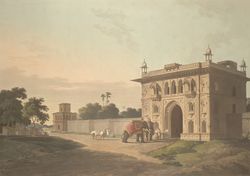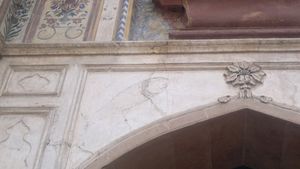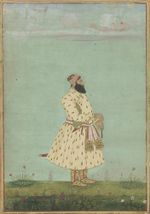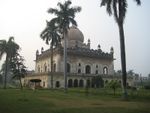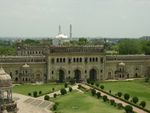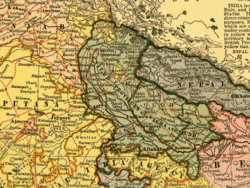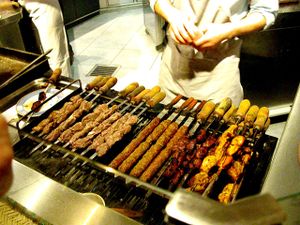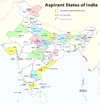أوده
أوده
Awadh अवध، اودھ | |
|---|---|
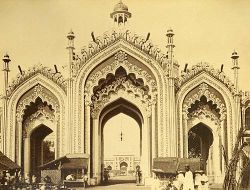 | |
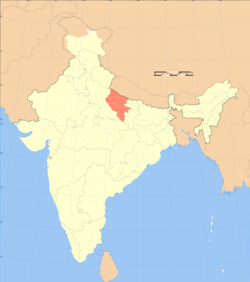 موقع أوده. | |
| البلد | الهند |
| الولاية | اوتار پرادش |
| الأضلاع | ضلع لوكناو، ضلع فايز أباد، ضلع دڤيپاتان، ضلع كانپور، ضلع الله أباد |
| اللغات | الأوده، الهندوستانية، الهندية، الفارسية، أردو |
| المقر | فايز أباد (القديم)، لوكناو (الجديد) |
| المنسوب | 100 m (300 ft) |
أوَده (أواده، هندي: अवध، أردو: اودھ تُنطق )، وتعرف أيضاً في النصوص التاريخية البريطانية أود أو أودى، وجميعها مشتقة من أيودا، هي منطقة في وسط ولاية اوتار پرادش الهندية المعاصرة، والتي كانت قبل يوم الاستقلال (الهند)الاستقلال تعرف باسم مقاطعات أگرا وأوده المتحدة. تأسست حوالي عام 1722 وكانت فايز أباد عاصمة لها وسعادت علي خان أول نوابها وسلف نواب أوده. كانت فايز أباد العاصمة التقليدية والأصلية لأوده، لكنها انتقلت لاحقاً إلى لوكناو، والتي تعتبر اليوم عاصمة ولاية اوتار پرادش.
التعريف الحديث لأوده يشمل جغرافياً أضلع ضلع أمبدكار نگر، بهاريتش، بالارامپور، بارابانكي، باستي]، فايز أباد، گوندا، هاردوي، لاكيمپور كري، لوكناو، |پراتاپگار، رايبلارلي، شراڤاستي، سيتاپور، سلطانپور وأوناو في أوده وضلع كانپور، كانپور دهات، فاتحپور، كاوشامبي والله أباد من دواب السفلى. شريط الأجزاء الشمالية في المنطقة، أي أجزاء من منطقة راي (تراي الداخلية وتراي الخارجية)، تقع حالياً في نيپال (تولسيپور دانگ) ومناطق رئيسية في ضلع گوراكپور. المنطقة موطن للهجة مميزة، الاوده، والتي يستخدمها الأودهيون.
التاريخ
أوده، والشهيرة بمخزن حبوب الهند، كانت ذات أهمية استراتيجية من أجل السيطرة على السهل الخصيب الواقع بين نهر الگانگ ويامونا والمعروف بالدواب. كانت مملكة ثرية، قادرة على الحفاظ على استقلالها من التهديدات القادمة من المارثا، بريطانيا والأفغان.
منذ عام 1350 كانت هناك أجزاء في منطقة أوده تحت حكم سلطنة دلهي، السلطنة الشرقية، امبراطورية المغل، نواب أوده، شركة الهند الشرقية والراج البريطاني. كانت لوكناو أحد المراكز الرئيسية لتمرد الهند 1857، حيث شاركت بفاعلية في حركة استقلال الهند، وظهرت كمدينة هامة في شمال الهند. لما يقارب أربعة وثمانون عاماً (من 1394-1479) كانت أوده جزءاً من السلطنة الشرقية في جوانپور؛ وجعلها الامبراطور همايون جزءاً من امبراطورية المغل حوالي عام 1555. في عهد الامبراطور جهانگير، منح مقاطعة في أوده لأحد النبلاء، الشيخ عبد الرحيم، الذي كان مقرباً منه. لاحقاً بنى الشيخ عبد الحميد ماتشتشي باوان في هذه المقاطعة؛ والتي أصبحت لاحقاً مركزاً لسيطرة أحفاده، شيخزاده، على المنطقة. حتى عام 1719، كانت صوبه في أوده مقاطعة تابعة لامبراطورية المغل ويديرها نظام أو نواب يعينه الامبراطور. نواب، وتعني النائب أو المساعد- كان لقباً يطلق على الحكام المعين من قبل امبراطور المغل في الهند ليساعده في ادارة الامبر طورية. في غياب وسائل النقل السهلة والاتصالات السريعة، كانوا حكامًا مستقلين عمليًا لأراضيهم وكانوا يمتلكون قوة منح الحياة والموت على رعاياهم. كما دعا سادات خان الرحالة الفارسي برهان-الملوك وعينه نظام أوده عام 1722 الذي أسسه بلاده في فايز أباد[1] بالقرب من لوكناو. كان نواب لوكناو في الوقع هم نواب أوده، لكنهم اشتهروا بهذا اللقب في إشارة لمنطقة النواب الثالث، لوكناو التي أصبحت عاصمة لحكمهم. كانت المدينة عاصمة ثقافية لشمال الهند؛ وكان نوابها، بأنماط حياتهم النمطية والباهظة، وكانوا رعاة للفنون. في عهدهم ازدهرت الموسيقى والرقص، وأقيمت العديد من النصب.[2] ومن أشهر النصب الباقية حتى اليوم، بارا إمامبارا، تشوتا إمامبارا، ورومي دارواز. ومن أشهر الاسهامات الخالدة لهؤلاء النواب الثقافة المتنوعة المتوافقة دينياً والتي أصبحت تعرف بتهذيب گانگا-جاموني.
القديم
Awadh's political unity can be traced back to the ancient Hindu kingdom of Kosala, with Ayodhya as its capital. Modern Awadh finds historical mention only in the time of Akbar, in the late 16th century.
In prehistoric times, Awadh, reputedly the kingdom of Rama, contained five main divisions:[3]
- Uttara Kosala or the trans-Ghaghra districts, now known as Bahraich, Gonda, Basti and Gorakhpur.
- Silliana, consisting of lower range of hills to the north of Uttara Kosala, now belonging to Nepal, with the Tarai at its base.
- Pachhimrath, which may be roughly described as the country between Ghaghra and Gomti west to the line from Ayodhya to Sultanpur. This division included about third of present district of Faizabad (including Ambedkarnagar), a small portion of the north of Sultanpur, greater part of Barabanki, and sections of the Lucknow and Sitapur districts.
- Purabrath, which may be roughly described as the country between Ghaghra and Gomti east to the line from Ayodhya to Sultanpur. This division included about two-thirds of present district of Faizabad (including Ambedkarnagar), the north-eastern corner of Sultanpur, and parts of Mirzapur district and Jaunpur.
- Arbar, extended soutwards Gomti to the Sai river.
عهد المغل
From the pre-historic period to the time of Akbar, the limits of the province and its internal divisions seem to have been constantly changing, and the name of Oudh, or Awadh, seems to have been applicable to only one of the ancient divisions or Sarkars, nearly corresponding to old Pachhimrath. The title of Subedar of Awadh is mentioned as early as 1280 A.D., but it can only have denoted the governor of the tract of the country above defined. The Awadh of Akbar was one of the twelve (or fifteen) subahs into which he divided the Mughal Empire as it stood in the year 1590 A.D. As constituted at the end of sixteenth century, the Subah contained five sarkars, viz. Awadh, Lucknow, Bahraich, Khairabad and Gorakhpur, and these, again were divided in numerous mahals and dasturs.
Khan Zaman Khan Ali Asghar son of Qazi Ghulam Mustafa was appointed as Subahdar of Awadh during the reign of Farrukhsiyar. This appointment was made in place of 'Aziz Khan Chughtai'.[4] Later on, Mahabat Khan was appointed as Subahdar of Awadh in place of Khan Zaman Khan Ali Asghar who was all over again transferred to Azimabad (Patna) as Subahdar in place of 'Sar Buland Khan'.[5]
It seems to have been of nearly the same extent as the Province of Oudh at the time of annexation to British India in 1858, and to have differed only in including Gorakhpur, Basti, and Azamgarh, and in excluding Tanda, Aldemau, Rajesultanpur and Manikpur, or the territory to the east and South of Faizabad, Sultanpur, and Pratapgarh.[6]
عهد نواب أوده
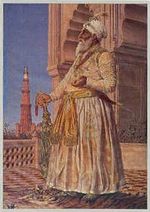
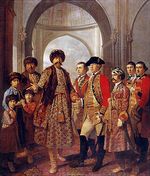
As the Mughal power declined and the emperors lost their paramountcy and they became first the puppets and then the prisoners of their feudatories, so Awadh grew stronger and more independent. Its capital city was Faizabad. Saadat Khan, the first Nawab of Awadh, laid the foundation of Faizabad at the outskirt of ancient city of Ayodhya. Faizabad developed as a township during the reign of Safdar Jang, the second nawab of Avadh (1739–54), who made it his military headquarters while his successor Shuja-ud-daula made it a full-fledged capital city. Suja-ud-daula, the third Nawab of Awadh, built a fort known as Chhota Calcutta, now in ruins. In 1765 he built the Chowk and Tirpaulia and subsequently laid out the Anguribagh and Motibagh to the south of it, Asafbagh and Bulandbagh to the west of the city. During the reign of Shuja-Ud-Daula, Faizabad attained such a prosperity which it never saw again. The Nawabs graced Faziabad with several beautiful buildings, notable among them being the Gulab Bari, Moti Mahal and the tomb of Bahu Begum. Gulab Bari is a striking building of fine properties, standing in a garden surrounded by a wall, approachable through two large gateways. These buildings are particularly interesting for their assimilative architectural styles. Shuja-ud-daula's wife was the well known Bahu Begum, who married the Nawab in 1743 and continued to reside in Faizabad, her residence being the Moti-Mahal. Close by at Jawaharbagh lies her Maqbara, where she was buried after her death in 1816. It is considered to be one of the finest buildings of its kind in Awadh, which was built at the cost of three lakh rupees by her chief advisor Darab Ali Khan. A fine view of the city is obtainable from top of the begum's tomb. Bahu Begum was a woman of great distinction and rank, bearing dignity. Most of the Muslim buildings of Faizabad are attributed to her. From the date of Bahu Begum's death in 1815 till the annexation of Avadh, the city of Faizabad gradually fell into decay. The glory of Faizabad finally eclipsed with the shifting of capital from Faizabad to Lucknow by Nawab Asaf-ud-daula.[7]
The Nawabs of Awadh were a Persian Shia Muslim dynasty from Nishapur,[8][9] who not only encouraged the existing Persian-language belle-lettrist activity to shift from Delhi, but also invited, and received, a steady stream of scholars, poets, jurists, architects, and painters from Iran.[10] Thus Persian was used in government, in academic instruction, in high culture, and in court,.[10]
Saadat Khan Burhanul Mulk was appointed Nawab in 1722 and established his court in Faizabad[11] near Lucknow. He took advantage of a weakening Mughal Empire in Delhi to lay the foundation of the Awadh dynasty. His successor was Safdarjung the very influential noble at the Mughal court in Delhi. Until 1819, Awadh was a province of the Mughal Empire administered by a Nawab.
Awadh was known as the granary of India and was important strategically for the control of the Doab, the fertile plain between the Ganges and the Yamuna rivers. It was a wealthy kingdom, able to maintain its independence against threats from the Marathas, the British and the Afghans.
The third Nawab, Shuja-ud-Daula fell out with the British after aiding Mir Qasim the fugitive Nawab of Bengal. He was comprehensively defeated in the Battle of Buxar by the British East India Company, after which he was forced to pay heavy penalties and cede parts of his territory. The British appointed a resident in 1773, and over time gained control of more territory and authority in the state. They were disinclined to capture Awadh outright, because that would bring them face to face with the Marathas and the remnants of the Mughal Empire.
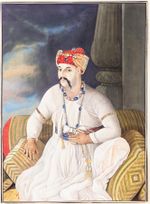
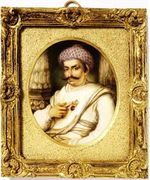
Asaf-ud-Daula, the fourth Nawab and son of Shuja-ud-Daula, moved the capital from Faizabad to Lucknow in 1775 and laid the foundation of a great city. His rule saw the building of the Asafi Imambara and Rumi Darwaza, built by Raja Tikait Rai Nawab Wazir (Diwan) of Awadh, which till date are the biggest architectural marvels in the city. Asaf-ud-Daula made Lucknow one of the most prosperous and glittering cities in all India. It is said, he moved because he wanted to get away from the control of a dominant mother. On such a thread did the fate of the great city of Lucknow depend.
In 1798, the fifth Nawab Wazir Ali Khan alienated both his people and the British, and was forced to abdicate. The British then helped Saadat Ali Khan to the throne. Saadat Ali Khan was a puppet king, who in the treaty of 1801 ceded half of Awadh to the British East India Company and also agreed to disband his troops in favour of a hugely expensive, British-run army. This treaty effectively made part of the state of Awadh a vassal to the British East India Company, though they continued to be part of the Mughal Empire in name till 1819.
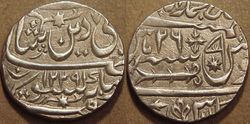
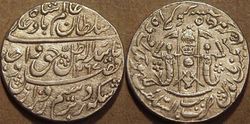
Coins were struck under the nawab's control for the first time in 1737, at a new mint opened in Banaras, although the coins named the Mughal emperor, not the nawab.[12] After the Battle of Buxar, the British seized Banaras, and so the mint was moved in 1776 to Lucknow. From there, coins in the name of the Mughal emperor continued to be struck, and they continued to name Muhammadabad Banaras as the mint. It was only in 1819 that Nawab Ghaziuddin Haidar finally started to strike coins in his own name. Soon thereafter, Awadhi coins started to feature the kingdom's European style coat of arms.
The wars and transactions in which Shuja-ud-Daula was engaged, both with and against the British East India Company, led to the addition of Karra, Allahabad, Fatehgarh, Kanpur, Etawah, Mainpuri, Farrukhabad, Rohilkhand, to the Oudh dimensions, and thus they remained until the treaty of 1801 with Saadat Ali Khan, by which province was reduced considerably as half of Oudh was ceded to the British East India Company. Khairigarh, Kanchanpur, and what is now the Nepal Terai were ceded in 1816, in liquidation of Ghazi ud din Haider's loan of a million sterling towards the expense of Nepal War; and at the same time pargana of Nawabganj was added to Gonda district in exchange for Handia, or Kawai, which was transferred from Pratapgarh to Allahabad.[6]
الحكم البريطاني
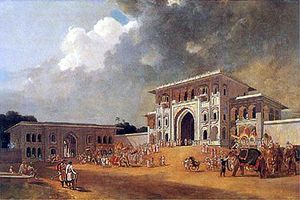
معاهدة 1801 formed an arrangement that was very beneficial to the Company. They were able to use Awadh's vast treasuries, repeatedly digging into them for loans at reduced rates. In addition, the revenues from running Awadh's armed forces brought them useful revenues while it acted as a buffer state. The Nawabs were ceremonial kings, busy with pomp and show but with little influence over matters of state. By the mid-19th century, however, the British had grown impatient with the arrangement and wanted direct control. They started looking about for an excuse, which the decadent Nawabs readily provided.
In 1856 the East India Company annexed the state under the Doctrine of Lapse, which was placed under a Chief Commissioner. واجد علي شاه, the then Nawab, was imprisoned, and then exiled by the Company to كلكتا. In the subsequent ثورة 1857 his 14-year-old son برجس قدرة ابن بگم حضرت محل was crowned ruler, and Sir Henry Lawrence killed in the hostilities.
في الثورة الهندية 1857 (also known as the First War of Indian Independence and the التمرد الهندي)، the rebels took control of Awadh, and it took the British 18 months to reconquer the region, months which included the famous Siege of Lucknow.
The Tarai to the north of Bahraich including large quantity of valuable forest and grazing ground, was made over to the Nepal Darbar in 1860, in recognition of their services during the Revolt of 1857, and in 1874 some further cessions, on a much smaller scale, but without any apparent reason, were made in favour of the same Government.[6]
In 1877 the offices of lieutenant-governor of the North-Western Provinces and chief commissioner of Oudh were combined in the same person; and in 1902, when the new name of مقاطعات أگرا وأوده المتحدة was introduced, the title of chief commissioner was dropped, though Oudh still retained some marks of its former independence.
الثقافة
منطقة أوده تعتبر مركز گنگا جمني تهذيب.[13]
شام أوده
شام أوده هو مصطلح شهير لليالي العامرة في عواصم أوده، فيض آباد ولاحقاً بشكل أكبر في لكنو حتى اليوم. تأسست أوده في عام 1722م، وكانت عاصمتها فيض آباد. ابن النواب شجاع الدولة، النواب آصف الدولة، نواب أوده الرابع، نقل العاصمة من فيض آباد إلى لكنو؛ مما أدى إلى اضمحلال فيض آباد وازدهار لكنو.
وكما أن بنارس (ڤرناسي) تشتهر بصباحها، فإن لكنو تشتهر بلياليها. فالعديد من المباني الشهيرة أقيمت على ضفاف نهر گومتي في زمن النواب. وبالإمكان مشاهدة الجمال المعماري بأخذ رحلة في نهر گومتي في المساء. وكان النواب يأخذون نزهات نهرية في المساء، ولذلك كانت شام أوده حافلة بالرومانسية.[14]
وثمة مثل يقول: 'شام أوده، شـُبـَه بنارس' ويعني ليالي أوده وصباحات بنارس (ڤرناسي) متميزة.
المطبخ الأودهي
المطبخ الأودهي يتركز في مدينة لكنو وجوارها. أنماط الطهي في المدينة تتشابه مع تلك في آسيا الوسطى، الشرق الأوسط، وكذلك شمال الهند. وتألف ذلك المطبخ من وجبات نباتية وغير نباتية. تأثرت أوده كثيراً بأساليب الطهي لدى المغل، ويحمل مطبخ لكنو تشابهاً بمطابخ كشمير، الپنجاب وحيدر آباد؛ وتشتهر المدينة بطعام النواب.
The bawarchis and rakabdars of Awadh gave birth to the dum style of cooking or the art of cooking over a slow fire, which has become synonymous with Lucknow today.[15] Their spread would consist of elaborate dishes like كباب، kormas, برياني، kaliya, nahari-kulchas, zarda, sheermal,Taftan, roomali rotis and warqi parathas. The richness of Awadh cuisine lies not only in the variety of cuisine but also in the ingredients used like لحم الغنم، paneer, and rich spices including cardamom and saffron.
في الثقافة الشعبية
The events surrounding the 1856 overthrow of Wajid Ali Shah and the annexation of Awadh by the British are depicted in the 1977 film The Chess Players by the المخرج الهندي الشهير ساتياجيت راي. This film is based on famous Urdu story Shatranj Ke Khilari by the great Hindi-Urdu novelist writer Munshi Premchand.
أفلام أومراو جان مبنية على العاصمتين الثقافيتين لأوده، لكنو وفيض آباد.
The region has been in the center of various period films of Bollywood and modern films like Main, Meri Patni Aur Woh and Paa to name a few. كما صُوِّرت في العديد من أغاني بوليوود.
انظر أيضاً
الهامش
- ^ "Faizabad, town, India". The Columbia Encyclopedia, 6th Edition. 2001–07 Archive copy at the Internet Archive
- ^ "Lucknow City". Laxys.com. Retrieved 29 April 2012.
- ^ Irwin, Henry Crossly (1880). The Garden of India. Or, Chapters on Oudh History and Affairs. London: W. H. Allen. p. 106.
 هذا المقال يضم نصاً من هذا المصدر، الذي هو مشاع.
هذا المقال يضم نصاً من هذا المصدر، الذي هو مشاع.
- ^ Tazkirat us-Salatin Chaghta – A Mughal Chronicle of Post Aurangzeb Period (1707–1724) by Muhammad Hadi Kamwar Khan; edited Persian text and with an Introduction by Muzaffar Alam (1980), Centre of Advanced Study Department of History, Aligarh Muslim University, Aligarh (U.P.) -202001, India(page 234)
- ^ Tazkirat us-Salatin Chaghta – A Mughal Chronicle of Post Aurangzeb Period (1707–1724) by Muhammad Hadi Kamwar Khan; edited Persian text and with an Introduction by Muzaffar Alam (1980), Centre of Advanced Study Department of History, Aligarh Muslim University, Aligarh (U.P.) -202001, India(page 236)
- ^ أ ب ت Irwin, Henry Crossly (1880). The Garden of India. Or, Chapters on Oudh History and Affairs. London: W. H. Allen. p. 107.
 هذا المقال يضم نصاً من هذا المصدر، الذي هو مشاع.
هذا المقال يضم نصاً من هذا المصدر، الذي هو مشاع.
- ^ "Welcome to Faizabad History". official website of Faizabad district.
- ^ Sacred space and holy war: the politics, culture and history of Shi'ite Islam By Juan Ricardo Cole
- ^ Art and culture: endeavours in interpretation By Ahsan Jan Qaisar,Som Prakash Verma,Mohammad Habib
- ^ أ ب Encyclopædia Iranica "Avadh", E. Yarshater
- ^ "Faizabad, town, India". The Columbia Encyclopedia, 6th Edition. 2001–07
- ^ P.L. Gupta: Coins, 4th ed., New Delhi: National Book Trust, p. 178.
- ^ Malika Mohammada, The foundations of the composite culture in India, Aakar Books, 2007, ISBN 978-81-89833-18-3, http://books.google.com/books?id=dwzbYvQszf4C, "... developed in Awadh as a genre of composite creativity. ... of multiple Indian cultural traditions and provided glimpses of the Ganga-Jamuni tehzeeb of north India with Lucknow as its centre ..."
- ^ "Lucnow revisited again". lucknowrevisited.blogspot.com Monday, 26 February 2007.
- ^ The Sunday Tribune – Spectrum – Lead Article. Tribuneindia.com (13 July 2003). Retrieved on 18 July 2013.
للاستزادة
- "Oudh". The Imperial Gazetteer of India. 1909. p. 277.
- Short description is different from Wikidata
- Pages using infobox settlement with no coordinates
- Articles containing هندي-language text
- Articles containing أردو-language text
- Pages using Lang-xx templates
- Articles with hatnote templates targeting a nonexistent page
- Uttar Pradesh articles missing geocoordinate data
- All articles needing coordinates
- تاريخ اوتار پرادش
- فيضآباد
- الهند البريطانية
- لكنو
- أوده
- مناطق اوتار پرادش
- دول وأراضي تأسست في 1722
- ولايات وأقاليم مقترحة في الهند
- تأسيسات 1722 في الهند
